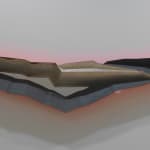Almuth Tebbenhoff German, b. 1949
Crack, 1993
Fabricated steel, painted
68 x 303 x 10 cm
26 3/4 x 119 1/4 x 4 in
26 3/4 x 119 1/4 x 4 in
Unique
“The Jodrell Bank Science Centre exhibition in 1994 started out as an exploration of imagined objects in infinite space. However, the concept was too wide and too remote from what...
“The Jodrell Bank Science Centre exhibition in 1994 started out as an exploration of imagined objects in infinite space. However, the concept was too wide and too remote from what was happening around me on earth. I became interested in quantum physics which took me back to the very small scale. So, I tore up the rule book of my own invented logic, smashed up my perfect geometry and started afresh. I ended up with pieces that looked like ancient geological formations, jagged and crushed. This seam seemed so true to my observation of life and death that I continued with it for many years.”
“When in 1993 I began working on the sculptures for the Jodrell Bank show, I found that the (almost slick) geometry didn't work for me anymore. One morning in a flash of clarity I saw that I had to break up all my straight lines. The 2D depictions of 3D objects looked more like rocky asteroids than sleek spaceships. I drew undulating lines freely onto huge sheets of cartridge paper at full scale. The largest span was almost 3m wide. Then I split the soft curves into angles and calibrated each break. I measured and transferred the angles to the big circular cutting machine that I'd bought for this purpose. It was a very slow process, but I enjoyed it the low rumble of the motor and the screech of the blade biting into the steel is still lodged in my memory.”
“When in 1993 I began working on the sculptures for the Jodrell Bank show, I found that the (almost slick) geometry didn't work for me anymore. One morning in a flash of clarity I saw that I had to break up all my straight lines. The 2D depictions of 3D objects looked more like rocky asteroids than sleek spaceships. I drew undulating lines freely onto huge sheets of cartridge paper at full scale. The largest span was almost 3m wide. Then I split the soft curves into angles and calibrated each break. I measured and transferred the angles to the big circular cutting machine that I'd bought for this purpose. It was a very slow process, but I enjoyed it the low rumble of the motor and the screech of the blade biting into the steel is still lodged in my memory.”
Provenance
From the artistExhibitions
Facets, 2025, Pangolin London Sculpture Gallery
Publications
Almuth Tebbenhoff Monograph, 2025, Unicorn Publishing GroupJoin our mailing list
* denotes required fields
We will process the personal data you have supplied in accordance with our privacy policy (available on request). You can unsubscribe or change your preferences at any time by clicking the link in our emails.



